Henon Bamboo Flowers Once Every 120 Years, then disappears for many years, and researchers do not know how it revives.
The unusual flowering time of Henon bamboo (Phyllostachys nigra) allows researchers to learn more about its mysterious regeneration process. The Henon bamboo flowers only once every 120 years before disappearing. The current generation of plants is expected to bloom in 2028. However, a research team from Hiroshima University in Japan has observed that some local specimens have started to flower early, and they seized this opportunity to study the Henon bamboo, as reported by Live Science on September 12.

The next expected bloom of Henon bamboo is in 2028. (Photo: Toshihiro Yamada)
In a study published in the journal PLOS One, a team of experts led by Toshihiro Yamada, a conservation biologist and forest ecologist at Hiroshima University, found that many specimens flowering did not contain any seeds. Through observation, they also noted that no new shoots were developing from the root system of the flowering plants, indicating limited asexual reproduction. This means that many dense bamboo forests may find it very difficult to regenerate. After disappearing, they may be replaced by grasslands.
Henon bamboo was introduced from China to Japan in the 9th century, but scientific records on the reproductive process of this plant are very scarce. Their 120-year flowering cycle is based on records from the 9th century. Previous populations died shortly after flowering in 1908, before regrowing across Japan. Therefore, experts do not know much about the flowering ecology and regeneration process of Henon bamboo.
Yamada and his colleagues studied the early flowering population found in Hiroshima in 2020 with 334 nodes. The research team discovered that 80% of the flowering nodes over the past three years did not produce seeds. By the end of 2020, no bamboo nodes had survived. “The question remains open as to how the dead nodes are replaced by a new generation. Clearly, sexual reproduction does not occur because this plant does not produce seeds,” Yamada stated.
According to Yamada, the bamboo may regenerate underground, eventually sprouting new individual nodes. Once these nodes stabilize, the bamboo grows vigorously to compensate for the ineffective reproduction. However, the regeneration process can take many years, leading to significant biomass loss during the transitional period between two flowering cycles. This not only causes economic damage to local industries that use bamboo as a material but also leads to various environmental issues such as erosion and landslides.


















































